Baby-Led Weaning -> How to Get Started
As a first-time parent, I knew there were going to be an endless number of things that I was going to learn and experience with my baby. One experience I knew I could not wait for was to introduce Sloane to food.
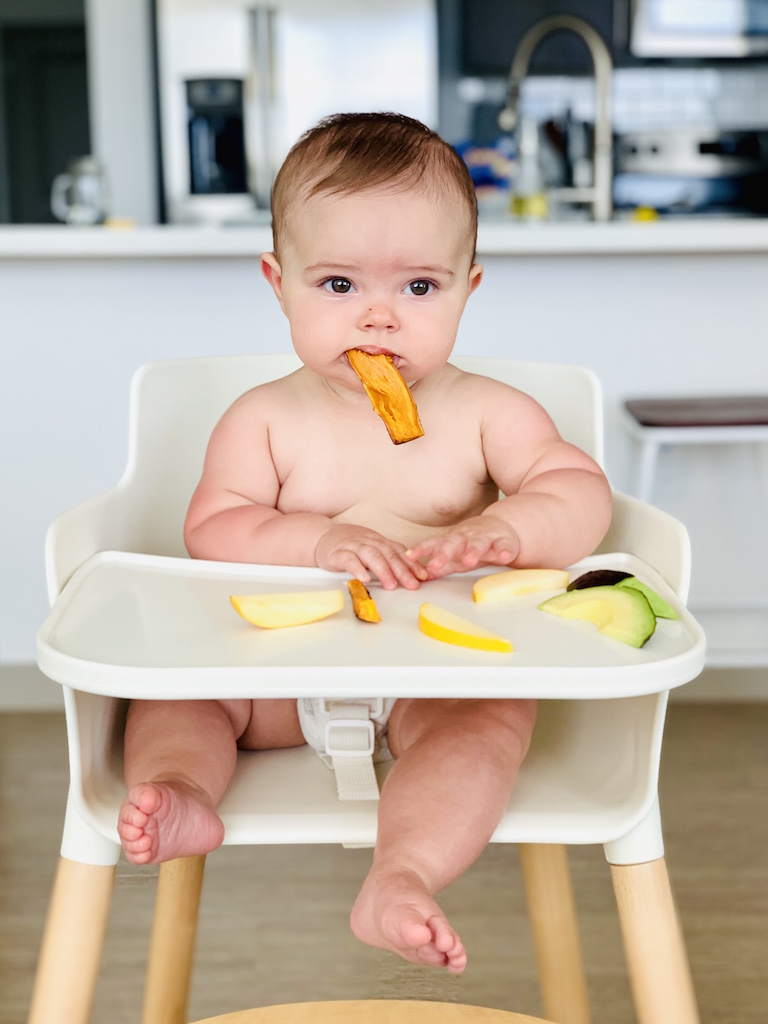
Over the past year, I have been sharing a lot of Sloane’s first food exposures and meals on Instagram. And over that time, I have gotten so many questions about how and when we decided to introduce certain foods to her. So now that she is 18 months old, and we have over a year of experience at this, I thought it was time I write a post about it.
I am certainly no expert at this. Bbaby-led weaning has definitely worked for us, and I recommend it to anyone that asks me about it.
I took the Feeding Littles online infant course, and it was extremely helpful! They are so knowledgable. I felt at ease knowing that I was learning about this topic from a Registered Dietitian and a Feeding Therapist. I highly recommend their course if you are wanting to go in depth on all things baby feeding. But for now, I am going to tell you everything that I have done with Sloane. Thi is in hopes that it will help anyone that may not want to take a more extensive course.

What is baby-led weaning?
Baby-led weaning is essentially the idea that you give your baby solid foods right from the start. Rather than only start with purees or traditional baby foods. I know that the term “weaning” can make it sound like you are trying to wean them from the breast or bottle, but that is not the case. You still want to offer breastmilk or formula until they are at least 12 months old. It really just means that you will be weaning your baby toward solid foods. You do not rush them, and just letting them explore all the new flavors and textures.
Whether you are choosing to do baby-led weaning with your baby, or opt for a few purees alongside, the choice is totally up to you. You have to do what is best for YOU and YOUR baby. Feeding your baby shouldn’t pose any strict rules, always do what you are comfortable with.
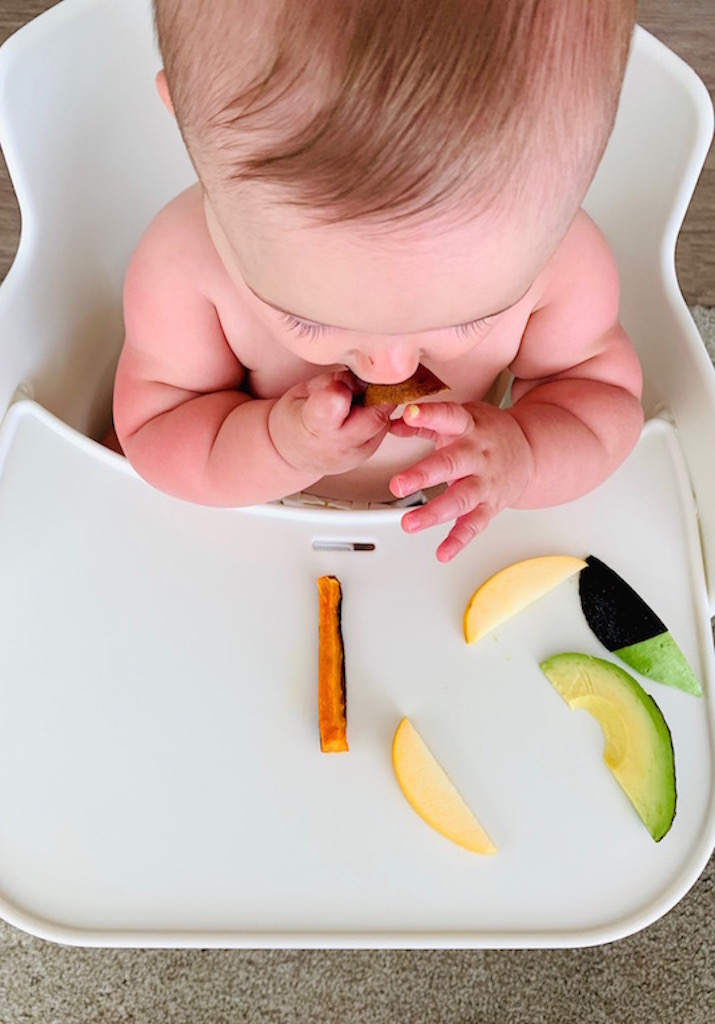
The Benefits of Baby-Led Weaning
One of the main reasons I wanted to do baby-led weaning is because it helps babies work on their fine motor skills. Also, it helps boost their oral motor development. By feeding them this way, they are constantly able to pick up different shaped foods with their hands and fingers. Also, they feel the different textures in their hands. And in turn, this will hopefully help them to become less picky eaters in the long run. They are exposed to foods in their natural state instead of everything being pureed.
One of the biggest benefits, according to some feeding experts, is that babies are able to learn the feeling of satiety (fullness). They will be able to listen to their bodies. They will know when they are full, and won’t be pressured to eat “just one more bite”. If they are only being fed purees, then they will end up eating the food faster. Their stomach won’t catch up their brain to let them know that they are full before eating more than they actually needed.
What about Choking?
One of the main concerns that parents usually have with baby-led weaning is choking. Most people are taught to believe that purees are safer than solid foods. However, from what I learned from Feeding Littles, that is not completely true.
The gag reflex on babies is more toward the front of their tongue than adults is. It is very common for babies to gag on their food, but gagging and choking are two very different things. When a baby gags, it is only because they are trying to learn how to move food around in their mouth, as well as learn how to chew.
Gagging is common and normal, and you will hear them make a sound, or even cough. The cough or gagging sound is actually a good thing because you know that their airway is not blocked. It is when they look like they are gagging. But no sound is coming out, that they could potentially be choking.
There has been research that says that babies who are given solids (cooked in the right way) are no more likely to choke than babies that are spoon-fed. As long as you stay away from foods that are known choking hazards, you should be just fine. (I will go over choking hazards down below.)

When to Start
There is so much research out there that says that babies really should be 6 months old when you start introducing solids. Their little digestive tracts are just not ready for solid food before then, so that is why we didn’t give Sloane anything but breastmilk before she turned 6 months. Ultimately, the choice is completely up to you and your pediatrician. Do whatever works best for you.
Another important milestone that needs to be met before you start solids is that your baby needs to be able to sit up on their own. When you put them in the highchair, you don’t want them to be hunching over and not able to hold themselves up, this could potentially turn into a choking hazard. They also need to be able to pick up food with their palms, so let your baby be the guide on when to start.
Start Slowly
At first, your baby will have a hard time picking up certain foods, they usually don’t develop their pincer grasp until around 9-10 months old. So this means that they will grasp the food with their hand, and only eat the part that is sticking out of their palm. You want to make sure that you cut foods into longer strips so that they have something to work with.
I think one of the biggest things that I learned from Feeding Littles is to not rush the process. Some babies take to food very quickly, and actually start eating some substance right away. And some babies just play with the food for a while. Both are perfectly fine! Babies need to play with the food to be able to get comfortable with the textures and flavors. All of this is new to them, so just be patient and know that if your baby isn’t eating the food right away, it’s okay!
You can introduce foods to your baby in a couple of different ways. You can just place a couple pieces of food onto the highchair and let them pick it up and play with it. Or, if they are having a hard time with that at first, you can put the food right into their hand and help them grasp it.

Let’s Talk About Food Allergies
Introducing common food allergens can be a sensitive subject for some people, especially if you have food allergies in your family. I won’t lie, I was a little hesitant about giving Sloane gluten because of my obvious allergy. This is definitely something that you want to talk to your pediatrician about because every baby is different, and every family history is different.
There are a lot of traditional thoughts about introducing food allergens one at a time, and some not until after the baby turns one. But these days, there is more and more research saying that the earlier you start introducing the common allergens, the less likely a baby is to develop an allergy to that food. Feeding Littles talks about this in their course, and I talked to Sloane’s pediatrician about it and she recommended that I introduce the foods to her early on. Luckily, she has never had a reaction to any food.
What foods do I start with?
There are really no rules as to which foods to start feeding your baby. This is all going to depend on the typical diet of the parents. The one thing you definitely want to take into consideration, though, is processed foods because of their sugar and salt content. Feeding your baby whole foods is always going to be better for their little bodies.
I started with pretty simple foods for Sloane. Avocado, roasted sweet potato, strips of ripe mango, etc. And then as she got used to those foods, I would add more. I ended up getting more and more creative as time went on because I got more comfortable with feeding her. Before I knew it, she was eating full meals with several components, not just single foods.
I started with just giving her foods at breakfast and dinner every day. We did that for a few weeks, alongside with me nursing her as I normally would throughout the day. She obviously wasn’t eating a ton at each meal, but she was learning.
I would always make sure that I nursed her before each meal so that she didn’t come to meal time hungry. Babies that are new to BLW can get frustrated if they are hungry because they don’t know how to technically feed themselves yet.

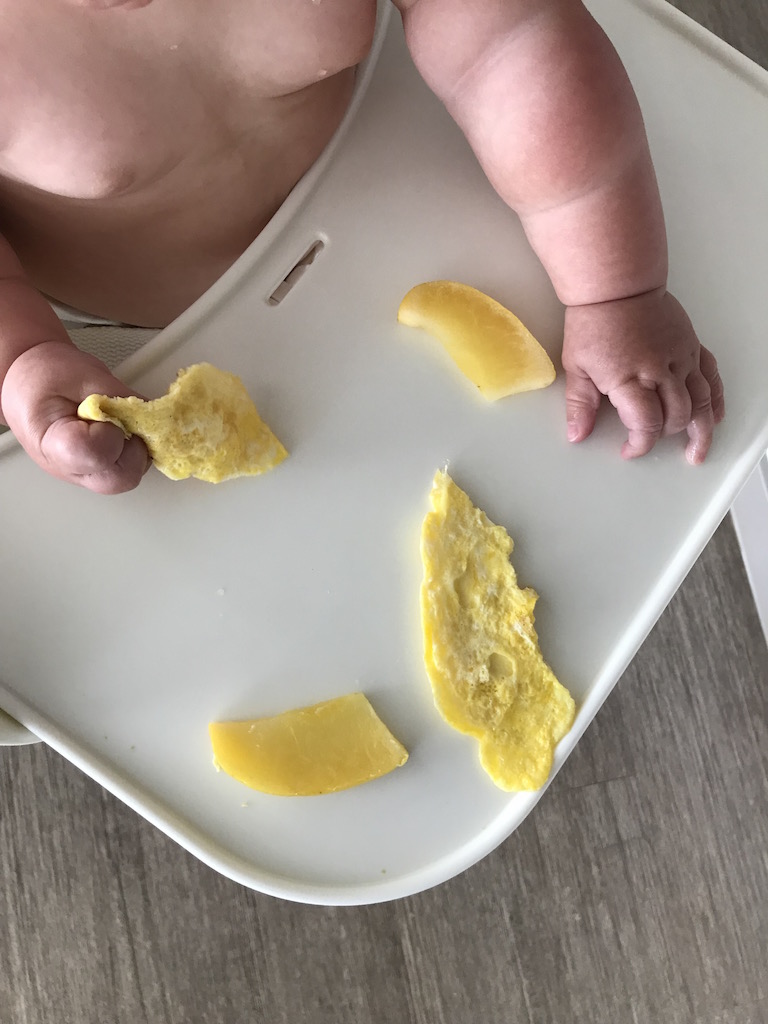
Foods to NOT give babies
While baby-led weaning advocates for babies to eat what the family eats, in a modified way, there are still some foods that babies cannot have right off the bat.
Honey is a big no-no for babies. Their bodies cannot handle honey until they are at least 12 months old because it can cause infant botulism.
Common choking hazards also shouldn’t be given to babies, and some even need to be avoided into toddlerhood. These include certain chips and hard crackers, hard candy, dollops of nut butters, whole grapes, certain hard raw veggies, and whole nuts.
Salt should also be very limited until they are at least 1 year old because their kidneys can’t handle much salt yet. Same goes for sugar, the AAP recommends that you not give your baby any sugar or sugar-sweetened beverages until at least 2 years of age.

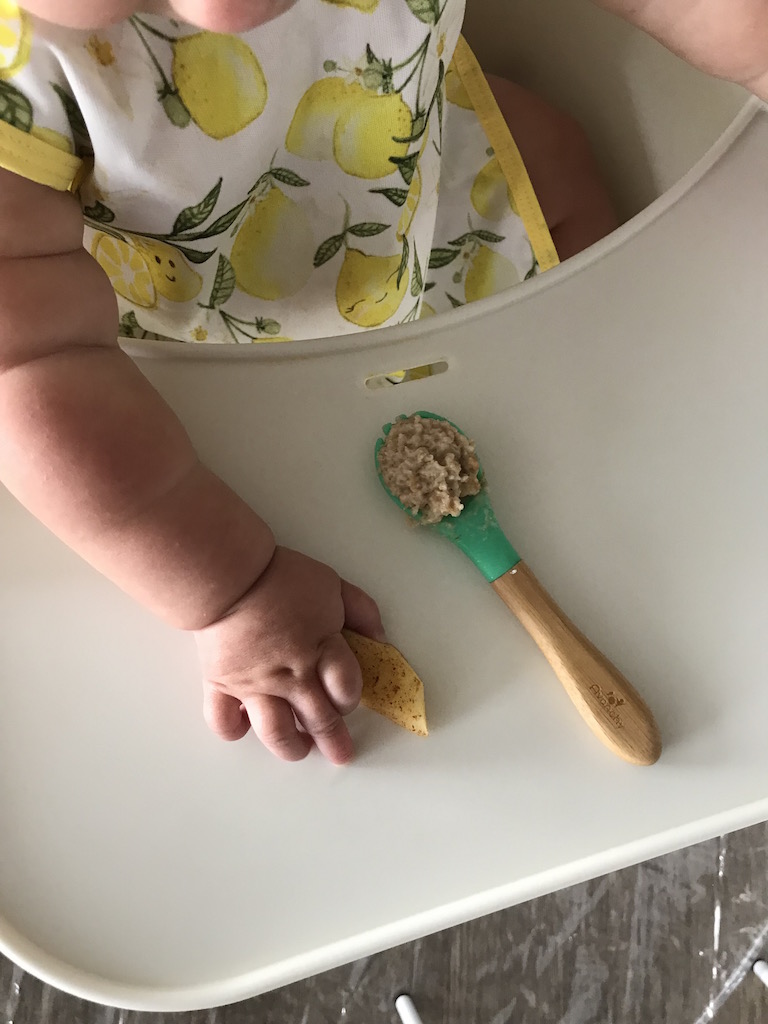

First Food Ideas
Here are a few things that I made for Sloane in the first couple of months of BLW…
roasted sweet potato wedges
I would roast them either with olive oil, or I would do coconut oil and cinnamon
avocado
sometimes I would leave the skin on half of the strip to help her grip it, and sometimes I would leave the skin off and roll the avocado in almond flour to give her some grip (just pay attention to make sure they don’t try to eat the skin!)
mango strips
make sure the mango is very ripe so that it is soft enough
steamed apple wedges
raw apples can be a choking hazard for them because they don’t have teeth yet, so I would steam them until they were soft, sometimes I would throw some cinnamon on them too
egg strips
I would basically make scrambled eggs, except sort of like in omelette form. I would just let the eggs cook in an even layer, and then cut it up in strips so she could grip them.
banana
I started out by just breaking the banana in half and handing it to her, then after a while, I would cut them into coins
toast strips
lightly toast some GF bread so that it is not too crunchy, and I would spread a VERY thin layer of peanut butter or avocado
strawberry strips
I would take large strawberries and cut them into thinner strips or wedges
frittata
you can chop up bell peppers and spinach very finely and put them in a frittata
pesto pasta
penne pasta with homemade kale pesto
fish
she loved salmon and we would give her little pieces of ours
chicken
i would sometimes give her small pieces of shredded chicken if it wasn’t too salty
date balls
you can make date balls (or energy bites) out of dates and nuts and roll them into balls, just make sure everything is very finely chopped, and there are not big pieces of nuts
baby oatmeal
you can definitely use regular oats, but I used baby oatmeal for a few months because it is fortified with iron, I would mix it with breastmilk and cinnamon, and sometimes even added in flax or hemp seeds
yogurt
I gave her dairy-free coconut yogurt, as well as Siggi’s yogurt to introduce her to dairy, we have never given her fluid milk to drink
There are SO many more fruits, vegetables and meals that you can give your baby, these are just a few ideas!

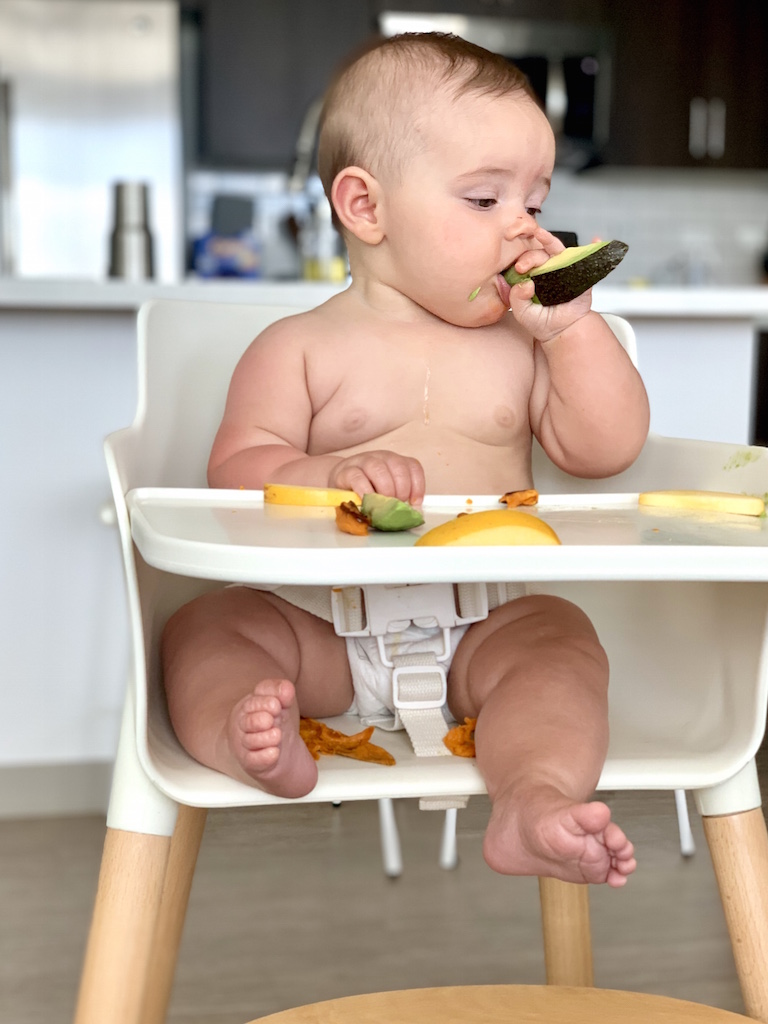
Baby Products I love
- Gootensils – these are a great first utensil because it helps the food grip to the utensil when your baby can’t scoop yet
- Baby utensils
- Honey Bear Straw Cup – this cup is genius and how we taught Sloane to drink from a straw
- Small Open Cups
- Bumkins Suction Plates and Bowls – these are great for when babies are still young and can’t flip the plate. They eventually learn how, though. We really just gave Sloane the food right on her highchair for the first several months.
- Munchkin 360 cup – it took Sloane a while to figure this out, but when she eventually did, it has been great. You don’t have to worry about the cup leaking when they carry it around.
- Baprons – these things are one of my favorite baby products ever! Sloane always hated bibs around her neck when she ate, so these things are a God send. They cover their entire front, and you can throw them right in the wash when needed.
- Reusable snack bags – I use these to bring snacks for Sloane in my diaper bag. They are durable, wash easily, and cute!
Always remember, no matter what way you decide to feed your baby, you are doing a great job! Every baby is different, just have some fun and let your baby play!

This has so much good info! My third kiddo is 7 mos old and is not loving food. That’s a first for us! Pedi suggested BLW but she’s not liked anything so far. I just keep trying. Hopefully soon she will realize how delicious food is!
I’m so glad it is helpful! And hang in there, mama! I’m sure she will come around to food soon 🙂